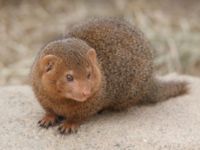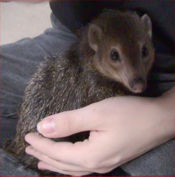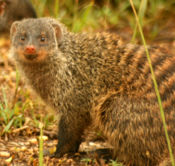Mongoose
2007 Schools Wikipedia Selection. Related subjects: Mammals
| iMongoose | ||||||||||
|---|---|---|---|---|---|---|---|---|---|---|
 Dwarf Mongoose
|
||||||||||
| Scientific classification | ||||||||||
|
||||||||||
|
|
||||||||||
|
Herpestinae |
A mongoose is a family of small cat-like carnivores. Mongooses are found just about everywere: Asia, Africa, the Caribbean, and southern Europe. There are more than thirty species, ranging between one and four feet in length. Mongooses are mostly carnivores, feeding on insects, crabs, earthworms, lizards, snakes, rodents, and other creatures. They will also consume eggs and carrion. Some species, such as H. edwardsii, the Indian mongoose, are popularly known for their ability to fight and kill venomous snakes such as cobra. They are able to do this because of their speed, agility, and cunning, but typically avoid the cobra and have no particular affinity for consuming their meat.
Some species of mongoose can be easily domesticated, are fairly intelligent, and can be taught simple tricks, so they are often kept as pets to protect the home from vermin. However, they can be more destructive than desired; when imported into the West Indies for the purpose of killing rats, they destroyed most of the small, ground-based fauna. For this reason, it is illegal to import most species of mongooses into the United States, Australia and other countries. Mongooses were introduced to Hawaii in 1883, and have had a significant impact on native species. Mongooses are sometimes referred to as "the most dangerous animals on the planet" for this reason.
In Okinawa, Japan, there is a tourist attraction where a mongoose and a type of local venomous snake, the habu (one of various Trimeresurus species) are placed in a closed perimeter and made to fight, while spectators watch. However, due to pressure from animal rights activists, the spectacle is less common today.
The plural form of mongoose is properly mongooses. The common form mongeese is technically incorrect since the words goose and mongoose are linguistically unrelated. The word mongoose is derived from the Marathi word mangus.
Herpestinae
Herpestinae is a subfamily of Mongoose. The mongooses belong to one of four families of terrestrial cat-like mammals descended from the Viverraines, which were civet/ genet-like mammals. The mongoose family is a close evolutionary relation of the family Viverridae and mongooses are sometimes classified as members of this family; however, mongooses have characteristic and distinguishing morphological and behavioural features though they do have the same basic dental formula as the viverrids. In contrast to the arboreal, nocturnal viverrids, mongooses are more commonly terrestrial and many are active during the day. Most are solitary like the Egyptian mongoose but a few, for example meerkats, have well-developed social systems.
Mongooses have long faces and bodies, small rounded ears, short legs and long tapering tails. Most are brindled or grizzled; few have strongly marked coats. They have non-retractile claws that are used primarily for digging.
Less diverse than the viverrids, the 30 species and 11 genera of mongooses are assigned to only two subfamilies. The subfamily Herpestinae comprises 30 species of African and Asian mongooses, including the Cape gray mongoose, the Egyptian mongoose and the meerkat or suricate.
Mongooses are distributed throughout North Africa, Sub-Saharan Africa, the Middle East and Asia living in a variety of habitats from forests to open woodland, savanna, semi-desert and desert. Chiefly terrestrial, some are aquatic or semi-arboreal.
The Egyptian mongoose (Herpestes ichneumon) is sometimes held as an example of a solitary mongoose, though they have been observed to work in groups also.
The meerkat or suricate (Suricata suricatta) lives in troops of 2-3 families each comprising a male, a female and 2-5 offspring in open country in Southern Africa (Angola, Namibia, Botswana, South Africa). Meerkats are small, diurnal mammals foraging for invertebrates in open country. Their behaviour and small size (they weigh less than a kg) makes them very vulnerable to larger carnivores and birds of prey. However, the meerkat has been known to eat small birds that migrate through Southern Africa. To protect the foraging troops from predators, one meerkat serves as a sentinel - climbing to an exposed vantage point and scanning the surroundings for danger. If the sentinel detects a predator it gives a loud alarm call to warn the troop and indicate if the threat comes from the air or the ground. If from the air, the meerkats rush as fast as they can to the nearest hole. If from the ground, the troop flees but not quite so fast as meerkats are more able to evade terrestrial predators than airborne raptors.
In popular culture
- Rikki-Tikki-Tavi, the title character in Rudyard Kipling's story, is a mongoose. In the U.S., Rikki-Tikki-Tavi may be better known from the animated short film based on the story, directed by Chuck Jones.
- On the series Camp Lazlo, Patsy Smiles, who has a huge crush on the show's titular character, is a mongoose.
- The Pokémon Zangoose closely resembles a mongoose, not only in name but in its strong aversion to snakes. It is known to be the mortal enemy of Seviper, a venomous snake Pokémon. Although classified in the Pokédex as a "cat ferret Pokemon," real mongooses do not belong to the Felidae or Mustelidae families to which cats and ferrets respectively belong.
- Also in the Pokémon series (episode #20: The Ghost at Maiden's Peak) a Ghastly creates a mongoose to take out a snake Pokémon, Ekans. This is the only time a real animal is used in the series.
- Invader Zim's assistant GIR wanted to be a mongoose for his disguise. When Zim recommended a dog, he asked to be a mongoose dog.
- In the animated Disney film, The Lion King, there was a meerkat called Timon.
- There is a song by Donovan called Rikki Tikki Tavi, referencing Rudyard Kipling's famous mongoose.
- In the anime Revolutionary Girl Utena, Anthy Himemiya keeps a mongoose in her room for a single episode.
Classification
- FAMILY HERPESTIDAE
- Subfamily Herpestinae
- Genus Atilax
- Marsh Mongoose, Atilax paludinosus
- Genus Bdeogale
- Bushy-tailed Mongoose, Bdeogale crassicauda
- Jackson's Mongoose, Bdeogale jacksoni
- Black-footed Mongoose, Bdeogale nigripes
- Genus Crossarchus
- Alexander's Cusimanse, Crossarchus alexandri
- Ansorge's Cusimanse, Crossarchus ansorgei
- Long-nosed Cusimanse, Crossarchus obscurus
- Flat-headed Cusimanse, Crossarchus platycephalus
- Genus Cynictis
- Yellow Mongoose, Cynictis penicillata
- Genus Dologale
- Pousargues' Mongoose, Dologale dybowskii
- Genus Galerella
- Black Slender Mongoose, Galerella flavescens
- Cape Grey Mongoose, Galerella pulverulenta
- Slender Mongoose, Galerella sanguinea
- Namaqua Slender Mongoose, Galerella swalius
- Genus Helogale
- Desert Dwarf Mongoose, Helogale hirtula
- Dwarf Mongoose, Helogale parvula
- Genus Herpestes
- Short-tailed Mongoose, Herpestes brachyurus
- Indian Gray Mongoose, Herpestes edwardsii
- Indian Brown Mongoose, Herpestes fuscus
- Egyptian Mongoose, Herpestes ichneumon
- Indian Mongoose, Herpestes javanicus or Herpestes auropunctatus
- Long-nosed Mongoose, Herpestes naso
- Bengal Mongoose, Herpestes palustris
- Collared Mongoose, Herpestes semitorquatus
- Ruddy Mongoose, Herpestes smithii
- Crab-eating Mongoose, Herpestes urva
- Striped-necked Mongoose, Herpestes vitticollis
- Genus Ichneumia
- White-tailed Mongoose, Ichneumia albicauda
- Genus Liberiictus
- Liberian Mongoose, Liberiictis kuhni
- Genus Mungos
- Gambian Mongoose, Mungos gambianus
- Banded Mongoose, Mungos mungo
- Genus Mungotictis
- Narrow-striped Mongoose, Mungotictis decemlineata
- Genus Paracynictis
- Selous' Mongoose, Paracynictis selousi
- Genus Rhynchogale
- Meller's Mongoose, Rhynchogale melleri
- Genus Suricata
- Meerkat, Suricata suricatta
- Genus Atilax
- Subfamily Herpestinae



